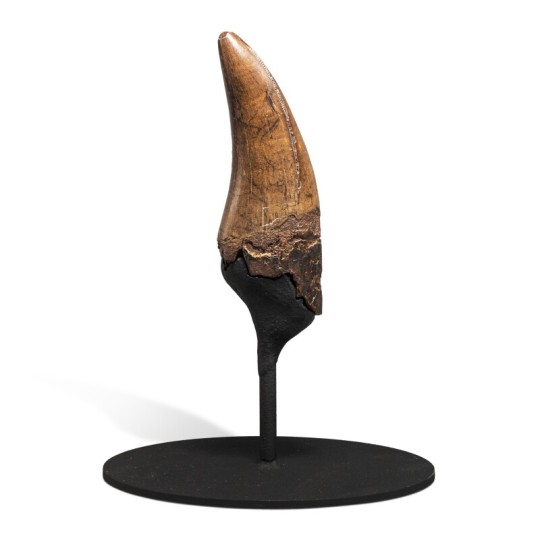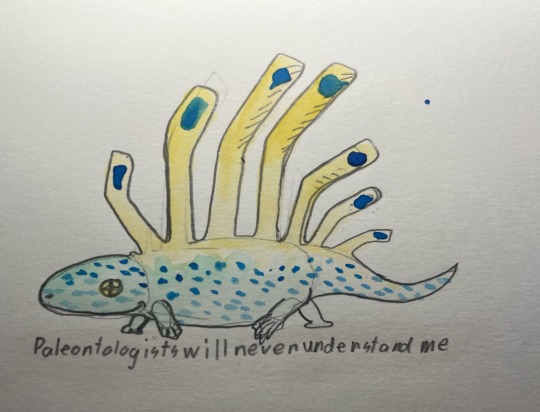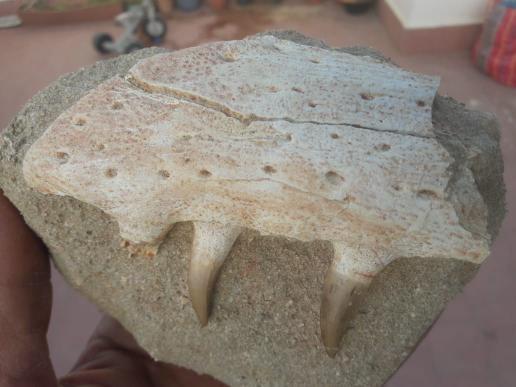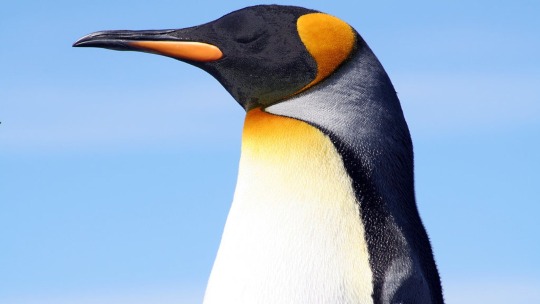#paleontologists
Text

Tyrannosaurus Rex Tooth
Late Cretaceous Period (approx. 67 million years ago)
Lance Formation, Niobrara County, Wyoming, USA
A LARGE AND WELL-PRESERVED TOOTH FROM THE MOST FEARSOME PREDATOR EVER TO WALK THE EARTH
No animal elicits the combination of fascination, reverence, and fear quite like that of Tyrannosaurus rex, the "tyrant lizard king." Dominating the western landscape of Late Cretaceous North America, T. rex's five-foot-long skull was packed with 60 teeth and featured a bone-crushing bite force of nearly 13,000 pounds (5,900 kg) per square inch, the strongest of any terrestrial animal other than its ancestor, Gorgosaurus. In comparison to other carnivorous theropods, T. rex teeth are proportionately huge. Robust and thickly-enameled crowns strengthened dozens of teeth, with serrations on both the posterior and anterior edges. The almost unrivaled power of this 40-foot-long (12.2 m) apex predator allowed it to hunt virtually every large dinosaur in its environment, including Triceratops, Ankylosaurus, Ornithomimus, Pachycephalosaurus, Edmontosaurus, and even other tyrannosaurs.
#Tyrannosaurus Rex Tooth#Late Cretaceous Period#Lance Formation#Wyoming#fossil#dinosaur#paleontology#paleontologists#archeology#archeolgst#history#history news#ancient history
61 notes
·
View notes
Text

longisquama
#longisquama#Paleontologists will never understand me#paleo meme#paleoillustration#paleo art#paleontologist#paleo#paleoblr#paleoart#paleomedia#paleontology#paleostream#paleontologists#lizards#frilled lizard#watercolor#traditional sketch#pencil
62 notes
·
View notes
Link
The fossil record is biased against bats. The flying mammals are small, making their fossilized remains very hard to find. And their light skeletons—ideal for flying around—mean it takes special circumstances for their bodies to be preserved. And yet, against these odds, paleontologists recently uncovered the exceptionally complete skeleton of what now stands as the earliest known bat.
To date, the most complete early bat fossils have come from an area paleontologists call Fossil Lake in Wyoming. The rock layers are world-famous for containing beautifully preserved fish, birds, mammals and other organisms that lived in the area about 52 million years ago. Among the stunning fossils recovered from these rocks, Naturalis Biodiversity Center paleontologist Tim Rietbergen and colleagues report Wednesday in PLOS One, are fossils of a new bat species the researchers have named Icaronycteris gunnelli. By comparing this new species with other early bats, paleontologists are beginning to develop a deeper understanding of how bats spread around the world in that period.
Continue Reading
193 notes
·
View notes
Text
Fascinating story.
73 notes
·
View notes
Note
im not sure if this counts but i acnt really find much info om how much the ratio of body size to wing ratios it would require for a mordern pterodactyl to take off without having to use its forelimbs?
Also if anyone has any aerodynamics programs i would love to see them
Thanks
Anyone on here a paleontologist? Or know about aerodynamics?
(This is from our research game!)
You guys know the drill, send this around until we find someone who knows!
(If not, this sounds like a situation that you could fictionalize. Send me a message if you want to talk more about it!)
#dinosaurs#paleontology#paleontologist#paleontologists#science#science side of tumblr#aerodynamics#the research game#research
14 notes
·
View notes
Link
23 notes
·
View notes
Text
"you can't judge people in the past" doesn't even apply to past paleontologists.
Y'all telling me they couldn't find a single butcher to ask about how to puzzle them bones?
Nah. They were dumb rich kids and you can't prove me wrong.
(I also don't know shit about Chinese paleontology history. Or any other country actually. I wonder who got closest fastest)
((also also the bone wars))
(((tangent. Did you hear what that one guy did to Troy?)))
#sally only sold the sea shells#she didn't puzzle together a salamander and say Behold A Man#paleontologists#paleontology#bad science#no consultation#no second opinions#history#don't meet your heroes#don't repeat the bone wars
3 notes
·
View notes
Photo

Mosasaur jaw section
8 notes
·
View notes
Text



Large Kranaosphinctes Ammonite
Late Jurassic Period (approx. 160 million years ago), Madagascar
While dinosaurs ruled the land during the Late Jurassic, the ammonite genus Kranaosphinctes could be found flourishing in the oceans.
Ammonites were a type of cephalopod — the taxonomic class that includes today's nautilus, octopus, and squid. Much like a submarine, ammonites employed gas- and liquid- filled chambers to regulate their position in the water column. The animal itself lived only in the outermost compartment, employing its tubular siphuncle to connect its chambers along the shell's ventral surface.
#Large Kranaosphinctes Ammonite#Late Jurassic Period#Madagascar#fossil#paleontology#paleontologists#archeology#archeolgst#history#history news#ancient history
51 notes
·
View notes
Text
The Lancetfish is a species that looks like it comes straight out of a realistic fantasy world building project.

#speculative biology#speculative ecology#speculative evolution#speculative zoology#traditional art#traditional sketch#spectember#specposium#paleontology#fanart#paleo meme#paleo art#paleontologist#paleostream#paleobird#paleomedia#paleoblr#paleoillustration#paleoart#worldbuilding#world#fishing#world building#fantasy#realistic fantasy#fish#lancet fish#lancetfish
65K notes
·
View notes
Link
More than 255 million years ago, in what’s now South Africa, enormous amphibians floated and swam through the ancient shallows. Paleontologists know this not from petrified bones but from marks left in the sediment by the living creatures. The Dave Green paleosurface, in the eastern portion of South Africa’s Karoo Basin, is covered with the tracks and body impressions of amphibious creatures that grew to more than five feet in length. “The more you look, the more you find,” says paleontologist David Groenewald of the University of the Witwatersrand in Johannesburg.
Groenewald and colleagues described the fossils, attributed to animals called rhinesuchid temnospondyls, Wednesday in PLOS One. Formed near the end of the Permian Period, prior to the world’s worst mass extinction, the expanse of olive-green rock was laid down by rivers that threaded across the prehistoric landscape. Those waterways, it would seem, were home to large amphibious vertebrates that paleontologists know as temnospondyls—roughly salamander-like animals that could grow to impressive sizes, effectively the alligators of their time. While temnospondyl bones have given paleontologists a general idea of what these animals looked like, the trace fossils are effectively the prehistoric behavior of these animals locked in stone.
Continue Reading
94 notes
·
View notes
Text
Fossilized Remains of 340-Pound Giant Penguin Found in New Zealand

(Sputnik, Wednesday February 08, 2023) —There are 17 to 19 species of penguins living today, most in the Southern Hemisphere. Also found in New Zealand and parts of Zealandia, are other flightless birds - like an ancestor to New Zealand’s beloved Kiwi and a giant “elephant bird” that also lived in Madagascar as recently as 800 years ago.
Fossilized remains of the largest penguin known to science were recently discovered in New Zealand, shocking researchers who determined the massive bird weighed hundreds of pounds.
Named Kumimanu Fordycei, Paleontologists believe the species could have weighed up to 340 pounds. By comparison, the average adult Male Western Lowland Gorilla Weighs about 300 pounds.
The fossil was discovered in a 57-million-year-old boulder that had been cracked open with the tides. Along with it they also found the remains of several individual specimens of another large but not quite as big previously undiscovered ancient penguin named Petradyptes stonehousei and fragments of two smaller yet-unnamed species of ancient penguins.
Scientists estimate the newly-discovered penguins lived around 60 million years ago. Petradyptes, they estimate, weighed around 110 pounds, far smaller than the Kumimanu, but still large for a penguin. The emperor penguin, the largest penguin on Earth today, can weigh up to just 88 pounds.
The fossils were discovered by Alan Tennyson, a paleontologist at the Museum of New Zealand Te Papa Tongarewa in 2017, but were described and named on Wednesday in the Journal of Paleontology.
Most of what scientists know about the Kumimanu fordycei came from a humerus bone, which was nine and a half inches long - about twice the length of those in the emperor penguin.
Paleontologists have been unable to determine the height of the ancient giant penguin but one estimated that it probably stood about 5 feet 2 inches. That gives the giant penguin a stocky build - the average aforementioned Western Lowland Gorilla 🦍 stands at about 6 feet while being roughly 40 pounds lighter.
Coming from an older branch of the tree of the penguin evolutionary tree, both the Kumimanu and Petradyptes differed in appearance from modern day penguins in more ways than just their size. Paleontologists say they had primitive flippers that resembled flying and diving birds like puffins. Their leg structure was also angled forward, unlike modern penguins whose legs are shaped like an upside down “L” coming out of their spine.

Scientists Discover New Penguin Colony in Antarctica Using Satellite Imagery (January 20, 2023)! “This is an exciting discovery. The new satellite images of Antarctica's coastline have enabled us to find many new colonies. And whilst this is good news, like many of the recently discovered sites, this colony is small and in a region badly affected by recent sea ice loss,” the British Antarctic Survey's Dr Peter Fretwell said.

'Human-Sized Penguin' Uncovered by New Zealand Schoolchildren Reveals Ancient Species (09/17/202)!
Mike Safely, president of the Hamilton Junior Naturalist Club, says this is an experience that the children involved will remember for the rest of their lives. “It was a rare privilege for the kids in our club to have the opportunity to discover and rescue this enormous fossil penguin.”
Dr. Daniel Thomas, a senior lecturer in zoology from Massey’s School of Natural and Computational Sciences, determined that the fossil was between 27.3 million and 34.6 million years old. Thomas compared the identified species to the Kairaku penguins that were first described from Otago, but with much longer legs.
"Longer legs would have made the penguin much taller than other Kairuku species while it was walking on land; perhaps around 1.4m tall, and may have influenced how fast it could swim or how deep it could dive."
New Zealand has been a hot spot for finding ancient penguin fossils. In 2017, a closely related Kumimanu biceae was described as living just a few million years after the fordycei and weighed 220 pounds. The slightly slimmer giant penguin had a sharp “stork-like” beak that researchers think may have been used to stab prey. The beak of the Kuminmanu fordycei has not yet been discovered.
In 2021, a 4.5-feet tall penguin with unusually long legs was described after a group of students in a fossil hunting club found fossilized remains on a small peninsula in the Kawhia Harbor during a field trip.
One explanation for why giant penguins thrived at the time is because they evolved shortly after the meteor that killed off the dinosaurs hit Earth. That impact also killed most of the sea-faring reptiles, leaving a niche open for a large amphibious predator to fill their space. Sea-faring mammals, like seals and whales, had not yet evolved. Paleontologists hypothesize that once mammals reentered the sea, the giant penguins were out-competed and only the smaller penguins survived.
It is also worth noting that scientists now believe New Zealand and the Island of New Caledonia are a part of the Earth’s eighth continent, with most of the landmass sitting below the sea. This continent is known as Zealandia, which they believe broke off from the Southern Hemisphere supercontinent of Gondwana about 105 million years ago.
What would become Zealandia then stretched out in a process scientists don’t yet understand. Scientists are still debating if most Zealandia was always submerged, with just small islands poking out, or if it sank at one point. In either case, a sinking continent or a collection of islands make for a natural habitat for penguins. If it did sink, scientists estimate that it would have taken over a hundred million years, meaning the giant penguins could have lived while much of Zealandia was still above sea level.
#New Zealand 🇳🇿#Penguin 🐧#Giant Fossilized Remains of Penguins 🐧 🐧 🐧#Sputnik International#Kumimanu Fordycei#Western Lowland Gorilla 🦍#Paleontologists#Petradyptes#Peninsula | Kawhia Harbor#Island of New Caledonia 🇳🇨 | New Zealand 🇳🇿#Southern Hemisphere | Supercontinent of Gondwana
1 note
·
View note
Text
I need all paleontologists to know that the giraffatitan is now called giraffe-a-dinosaur accordingto my 3 year old. This is official, please update all documents immediately
0 notes
Link
12 notes
·
View notes
Text
The University of California’s Museum of Paleontology defines palaeontology as the study of what fossils reveal about the ecologies of the past, evolution and the place of humans in the world. The various types of palaeontologists use knowledge from anthropology, archaeology, biology, geology, ecology and computer science to determine the origin and destruction of the different types of organisms that have existed on Earth.
1 note
·
View note